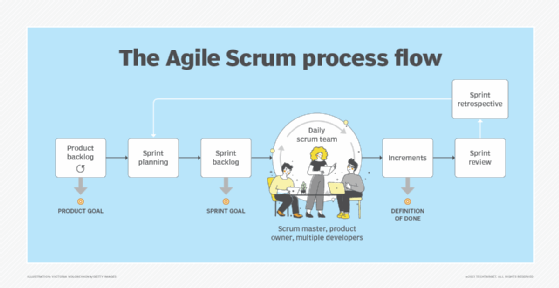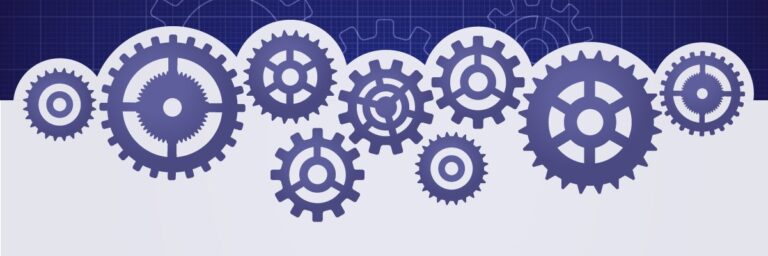Agile vs. Scrum: What’s the difference?
The key difference between Agile vs. Scrum is that Agile is a philosophy about how best to continuously deliver software to the client, while the Scrum framework is a development process teams can use to deliver products in an Agile manner.
How Agile and Scrum compare
Everything you need to know about the differences between Agile vs. Scrum can be found by comparing the Scrum Guide to the Manifesto for Agile Software Development. These are the defining documents for both Agile and Scrum.
What is Agile’s highest priority?
The Agile Manifesto, signed in 2001 by Martin Fowler, Jon Kern, Jeff Sutherland and 14 others, attests to the following four fundamental values:
- Individuals and interactions over processes and tools.
- Working software over comprehensive documentation.
- Customer collaboration over contract negotiation.
- Responding to change over following a plan.
The Agile Manifesto also includes 12 principles of Agile software development. These short statements explain how to best approach a software development projects. Examples include: “Our highest priority is to satisfy the customer through early and continuous delivery of valuable software,” and “Welcome changing requirements, even late in development.”
IT professionals who read the Agile Manifesto might be surprised by its brevity. In total, the discussion of the Agile Manifesto’s four values and 12 principles is less than 300 words in length.
Unlike the Scrum Guide, there is no discussion in the Agile Manifesto on how to implement its principles or practically apply its stated values. There are no instructions on how a team might develop an application in accordance with the Agile values and principles the Manifesto espouses.
The manifesto simply defines the basic philosophy that drives the behavior of an Agile software developer.
What does Scrum emphasize?
In contrast to the philosophical nature of Agile, Scrum is a product development framework that describes the high-level processes teams should follow in order to iteratively develop and incrementally deliver products in an Agile manner. Scrum is for teams to incrementally develop any type of product, not just software.
Scrum’s origins date back to the early 1990s; it was pioneered by Ken Schwaber and Jeff Sutherland and formally presented for the first time at an OOPSLA conference in 1995. Based on the practices of empiricism and lean thinking, the steps an organization must follow to implement Scrum were first officially published in the Scrum Guide in 2010.
While more verbose than the Agile Manifesto, the Scrum Guide is also relatively succinct. It is only 14 pages in length and has a verbiage of less than 5,000 words. Yet despite the Scrum Guide’s conciseness, it effectively describes:
- The responsibilities and accountabilities of developers, product owners and Scrum Masters.
- How to manage a software development from planning through to the sprint retrospective.
- The various Scrum artifacts a team should create to help track and monitor progress.
- The Scrum goals teams should define to help motivate developers and guide the team’s progress.
Scrum and Agile differences
While they are similar in many respects, here are five key differences between Agile vs. Scrum:
- Scrum can be used to develop any product, while the Agile Manifesto speaks specifically about software development.
- Agile is a philosophy, while Scrum is a framework.
- Scrum describes three key roles, while Agile emphasizes self-organizing teams.
- Scrum has five living values, while Agile has four fundamental tenets.
- Agile has 12 principles; Scrum has three pillars.
Agile describes, at a fairly abstract level, the thoughts and ideas that should drive and motivate a productive software developer. Scrum provides a more concrete set of steps to follow in order to continuously deliver software to the customer.
Agile and Scrum similarities
While there are many axes upon which a person can contrast Agile versus Scrum, there are also many similarities.
Although Scrum’s inception predates Agile by a decade, you will often hear developers describe Scrum as an Agile methodology. That’s because the Scrum Guide embraces many of the ideals and values articulated in the Manifesto.
For example, the Agile Manifesto places a great deal of emphasis on the “early and continuous delivery of valuable software.” Similarly, Scrum emphasizes short development sprints, where the goal of each sprint is to deliver something of tangible value to the client.
|
Scrum vs. Agile comparison chart |
||
|
Scrum |
Agile |
|
|
Inception |
Early 1990s |
2001 |
|
Founding document |
The Scrum Guide |
Agile Manifesto |
|
Creators |
Jeff Sutherland and Ken Schwaber |
17 signatories, including Kent Beck, Jon Kern and Dave Thomas |
|
Type |
Framework |
Philosophy |
|
Alternatives |
Kanban, Lean development, Scrumbut |
Waterfall and SAFe |
|
Prioritizes |
Iterative and incremental development |
Continuous delivery |
How Scrum and Agile work together
Despite their differences, Agile and Scrum should be considered as complementary ideas, not competitive viewpoints. That’s why many people often utter the terms Scrum and Agile in the same breath, and some describe Scrum as an Agile methodology.

Agile also emphasizes that “business people and developers must work together daily throughout the project.” Scrum, meanwhile, describes the different artifacts a product owner can use to communicate their goals in a transparent and properly understood fashion.
There are many ways to achieve success as an Agile team. Scrum is simply one approach, but it is the most popular approach. It helps teams iteratively and incrementally deliver products to the customer in a manner that is consistent with the ideas set forth in the Agile Manifesto.
Darcy DeClute is a technical trainer and Agile coach who helps organizations apply Scrum-based principles to adopt a modern DevOps stack. She is a certified Professional Scrum Master, Professional Scrum Developer and Professional Scrum Product Owner as well as author of Scrum Master Certification Guide.


